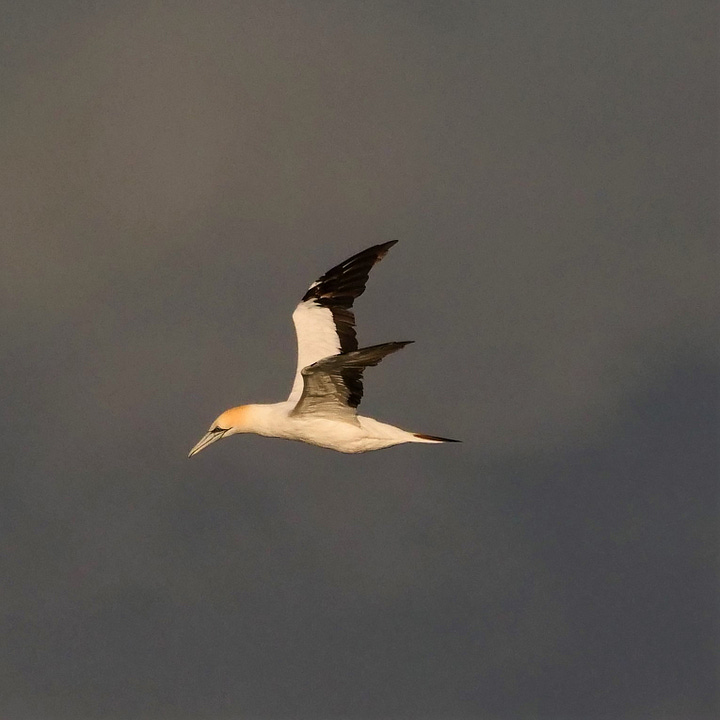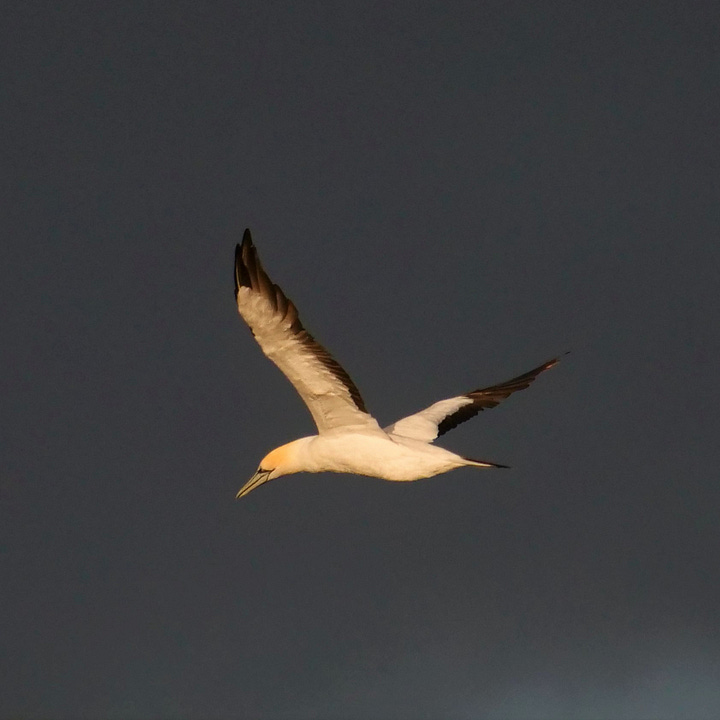I write another piece in my occasional series of bird life on the Manukau Harbour. This time more in sorrow than in joy. I have more than one motive in doing so. One such motive is to draw attention to the plight of the Aotearoa Bird Care centre in West Auckland. It leads a hand to mouth existence and needs donations.
The featured bird is an Australasian Gannet or Tākapu. Tākapu are not a common sight on the Manukau. I see them infrequently and my attempts to photograph them are not successful for the simple reason that they are far out diving into the deeper channels in search of food. I do have a few sequences of the birds as they plummet towards the surface of the sea but they are distant and have suffered blurring as a result. Whilst my photographic instinct might wish they were closer to the foreshore I think it is preferable they are not. Only once have I seen a bird flying near the land. It behaved peculiarly, flying backward and forwards. I realised it was clearly distressed but I know not why. At the foot I have included a couple of images where I was able to photograph Tākapu in full, glorious flight above the Manukau.
There is an ideal place to photograph Tākapu but the trouble is I would need to drive about 40 or 50 kilometres to get to there. Muriwai Beach is the northernmost beach of the series which lie between the Manukau heads in the south and the Kaipara in the north. At the southern end of Muriwai high on the sea cliffs which rise up from the beach there is a gannet colony. There is another such colony a few hundred kilometres away which is much larger but the Muriwai colony is home to thousands of birds. To a wildlife photographer it almost feels like cheating as there are viewing platforms around the colony which enables visitors to be within a few metres of the birds.
Aotearoa New Zealand is the primary breeding location for the Tākapu. However, once the young are ready they fly to Australia for a few years before returning to breed. As they are capable of flying great distances it is perhaps surprising that more don’t travel the relatively short distance to the Manakau to fish. I suppose it simply means that there is ample food sources closer to the colony. A day or so ago I was at a point on the Manukau called Lynfield Cove. The seascape accompanying this essay is taken from the Cove. The birds are present in numbers reflecting the presence of food in plenty. On that day there were several white-faced herons (Motuku-moana) and pied stilts (Poaka). As darkness descended I turned to walk back to the beach from about 80 metres along the foreshore. As I walked a luminescent white shape caught my eye about 20 metres to my right. I walked over to investigate and I almost wished I had not. It was a Tākapu.
He – I will call him a he because I have no idea how to sex birds who are not dimorphic – was in serious trouble. I took a photo before I realised just how damaged he was (see photo below). As can be seen his port side wing was at a strange angle and was clearly broken. I could get close enough to touch him but I didn’t as I am afraid of birds nipping me. I did not know what to do. I phoned a bird sanctuary near-by but I only got a recorded message. It suggested I phone the Department of Conservation (DOC) which I did. The operative was located in Wellington so he told me to wait and I would be phoned by an Auckland staff member. A woman who gave her name as Kathy phoned soon afterwards which was the good news. The bad news was that Tākapu are not considered sufficiently endangered for any official effort to be expended in attending to any one creature. Nonetheless Kathy offered to phone local veterinarians to see if they would take in the bird.
Kathy reported that a veterinary practice nearby would accept the bird. The trouble was they were to close in half an hour and it would take me all that time to walk back to my car before I could even return to pick up the Tākapu. Kathy then undertook to contact a local DOC volunteer who would meet me at Lynfield Cove. I met the young fellow at the beach. We then decided what the options were. He was not in a position to take the bird so the options reduced to leaving him there or me taking him. I took a large bag from my car and a blanket. The blanket was not to keep the bird warn but rather to ensure I did not get bitten when I picked him up. I need not have worried he was alive but floppy when I got back to where he was.
I took the bird home and left him in the bag in the back of the car. I checked him periodically and I could arouse him from what appeared to me to be a slumber. But as the evening wore on he was less and less responsive. In the morning I checked again. He was still warm but barely responsive. I immediately took him to the Aotearoa Bird Care centre and told them he seemed to have a broken wing. A staff member there took him away from reception. Reluctantly, I asked if he was going to make it. She said it was unlikely because he was basically comatose. She had also examined him and told me that there was blood under the wing. In other words, he was badly injured. I can only speculate on what caused the injury. It is unlikely to be a predator such as a cat as they are land based. It was not a fish hook. It follows that he must have collided with something.
I left the sanctuary feeling very much deflated. I have not contacted the bird sanctuary to ask if the Tākapu survived. I won’t. I prefer to think that a miracle happened and he survived. Perhaps I am guilty of anthromorphising and I have interfered in the natural order. Leaving aside my philosophical reservations I fervently hope injured birds are treated where possible. Unfortunately, the Aoteroa Bird Care facility is under threat of closure because of perennial shortage of finance. If anybody feels inclined to contribute I attach its webpage.
https://birdcareaotearoa.org.nz/







